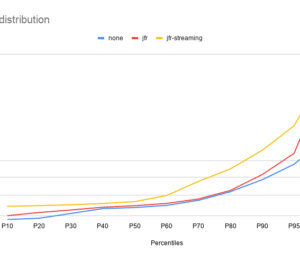Performance: Stream.concat vs. New ArrayList
- August 27, 2020
- 4756 Unique Views
- 4 min read
During a code review, I suggested some code improvements related to JDK8+ streams. The original code looked very similar to the following:
List<Element> result = content.getFancyStuffs().stream()
.flatMap(item -> {
List<Element> objects = new ArrayList<>();
objects.add(item.getElement());
objects.addAll(item.getElements());
return objects.stream();
})
.collect(toList());
Some more details here — the getFancyStuffs() returns a list of FancyStuff elements. The FancyStuff class contains two getters where getElement() returns a single Element whereas the getElements() returns (guess what?) a list of Elements.
The interesting part was the lambda which creates a new ArrayList and adds a single element objects.add(item.getElement()) and the second part which adds several elements via objects.addAll(item.getElements).
My suggestion, based on better readability, was to use the following code instead:
List<Element> result = content.getFancyStuffs().stream()
.flatMap(fs ->
Stream.concat(
Stream.of(fs.getElement()),
fs.getElements().stream())
)
.collect(Collectors.toList());
So far so good. But, after some time, I began to think about the two solutions. I asked myself: Which is faster? Which uses more memory? (The usual questions a developer is asking... don’t you?)
So what would you guess is the faster solution? The first or the second? My guess was that the first solution will win, but based on some assumptions. This means the number of elements which are coming through content.getFancyStuffs().stream().. are more or less small (less than 20) and furthermore the number of elements wich are returned by item.getElements() are fairly small as well (less than 20).
The only thing which can help here to get a reliable answer is to measure it. No assumptions, no educated guesses etc. So I have to make a real performance measurement. So I created a separate project which really measures the performance.
So the first code part for performance measurement looks like this:
Solution 1
Benchmark
public List<Element> with_new_arraylist(Container content) {
return content.getFancyStuffs().stream().flatMap(item -> {
ArrayList<Element> objects = new ArrayList<>();
objects.add(item.getElement());
objects.addAll(item.getElements());
return objects.stream();
}).collect(Collectors.toList());
}
and the second part:
Solution 2
@Benchmark
public List<Element> with_stream_concat(Container content) {
return content.getFancyStuffs()
.stream()
.flatMap(fs -> Stream.concat(Stream.of(fs.getElement()),
fs.getElements().stream()))
.collect(Collectors.toList());
}
while writing the above code, I thought about some parts of it and I came up with two other possible variations.
Solution 3
The following example where I put elements directly into the constructor of the ArrayList. This means it could only happen that in rarer cases the size of the array list must be resized which depends on the number of elements in item.getElements().
@Benchmark
public List<Element> with_new_arraylist_constructor(Container content) {
return content.getFancyStuffs().stream().flatMap(item -> {
ArrayList<Element> objects = new ArrayList<>(item.getElements());
objects.add(item.getElement());
return objects.stream();
}).collect(Collectors.toList());
}
Solution 4
Finally, this one where I already calculate the size of the final list by giving the number of elements via the constructor. This will prevent the resizing of the array list at all cause the size will fit always.
@Benchmark
public List<Element> with_new_arraylist_constructor_size(Container content) {
return content.getFancyStuffs().stream().flatMap(item -> {
ArrayList<Element> objects =
new ArrayList<>(item.getElements().size() + 1);
objects.add(item.getElement());
objects.addAll(item.getElements());
return objects.stream();
}).collect(Collectors.toList());
}
Measurement
The measurement was done on an Intel Xeon Machine with 3.50GHz with CentOS Linux release 7.6.1810 (Core).
The full source code of the project can be found here: https://github.com/khmarbaise/performance-concat.
Basic Measurement
So I began very simple only with the first two solutions (1+2):
The following is only an excerpt of the above detailed measurement result (I have remove the prefix BenchmarkStreamConcat from all results here in the post).

So, if you take a look at the results above, you can already see that for a small amount of elements (49 getElements, 50 FanceStuff instances) the one with stream_concat is faster. Hmmm... is this really true? Not a measuring error or coincidence?
Parameterized Measurement
To reduce the likelihood of stumbling over a coincidence or a measuring error, I changed the code which now takes a parameter and enhanced the number of elements. I stick with the two solutions (1+2).
The getElements() results always in 49 elements whereas the number of FancyStuff elements varies (see count). The following result shows that the version with stream_concat is always faster.

Interestingly, this is not only the case for larger number of elements. It is also for a small number of elements the case.
Running all solutions
So, finally, I ran all solutions (1+2+3+4) with different numbers (count, elementCount) with different combinations. I honestly have to admit that I underestimated the time it would take to run that test (it took 13 hours+).
I just picked up some examples of the measured times here:

Another run
So I ran also a solution with all possible options im JMH which took very long (1 day + 15 hours+).
So I will pick up some examples of the measured times here:

So finally the question comes — what do the numbers actually mean?
A quote from the JMH output:
REMEMBER: The numbers below are just data. To gain reusable insights, you need to follow up on why the numbers are the way they are. Use profilers (see -prof, -lprof), design factorial experiments, perform baseline and negative tests that provide experimental control, make sure the benchmarking environment is safe on JVM/OS/HW level, ask for reviews from the domain experts. Do not assume the numbers tell you what you want them to tell.
Note: Used with permission and thanks — originally written by Karl Heinz Marbaise and published on Karl Heinz Marbaise's blog.
Don’t Forget to Share This Post!








Comments (0)
No comments yet. Be the first.